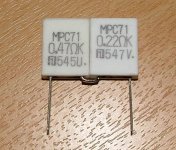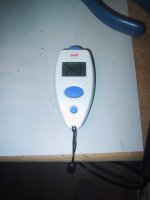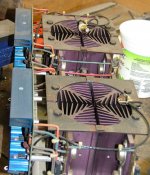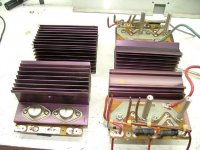rabstg said:The question about input transformers was not the issue, the ensuing debate that caused people to become defensive is.
We don't need arguments over whether transformers are good or bad, but the different options to do balanced are welcome.
I am not a moderator(nor want to be) but this thread has been remarkably consistent and friendly... I would hate to see it change from an innocent comment or belief.
Cheers.
I thought that removing any discussion on individual design elements might kill what I really want to implement.
pinkmouse said:I don't think the GB will be held up at this point!
I was talking "after market" mods. 😉
Cool, I'm all for that.
Blessings, Terry
My plan is to only build it up to the driver stage to confirm that the main board is good. The output boards are very simple and a quick "light through" comparison on my tranaparency light table will yield any differences that would need to be corrected. I should be able to have that all answered by Saturday at the very latest.
Anyway, with the 2 for 4 deal we will still have the boards here to ship in just three weeks with doing the proto test.
The way I see the trafo thing is as a do what you want to do.... but its not in the spirit of whats been going on here since the start of the thread. Perhaps applying a trafo input would be a good thread all of its own, especially since its applicable to alot of other amps out there. Of course any changes to make the KSA-50 an electronic balanced input should be included in this thread and on the builders WIKI. Really...... it should be pretty simple to do!
Mark
Anyway, with the 2 for 4 deal we will still have the boards here to ship in just three weeks with doing the proto test.
The way I see the trafo thing is as a do what you want to do.... but its not in the spirit of whats been going on here since the start of the thread. Perhaps applying a trafo input would be a good thread all of its own, especially since its applicable to alot of other amps out there. Of course any changes to make the KSA-50 an electronic balanced input should be included in this thread and on the builders WIKI. Really...... it should be pretty simple to do!
Mark
INA134
Just so you know, the INA134 does not need a "regulated" supply, it will work unregulated (only reason I used a regulated supply was to goof around with surface mount chips), and you don't need to add any other opamps, matched or not. Look at the data sheet (at www.ti.com), it can be configured with various gains (I think 1/2 and 2).
Just so you know, the INA134 does not need a "regulated" supply, it will work unregulated (only reason I used a regulated supply was to goof around with surface mount chips), and you don't need to add any other opamps, matched or not. Look at the data sheet (at www.ti.com), it can be configured with various gains (I think 1/2 and 2).
lgreen said:What are some R and C values that would be good to start with?
R between 10 and 100 Ohms
C between 10 and 100 nF.
Relation is : L= C/ sqr(R)
The L is determined by the load, not the amplifier.
The values chosen on Jan Dupont's layout are 10R and 100nF, keeping the R value low keeps the power rating low.
I think the idea was to keep the little Krell original, and Al's board layout has gone through all the motions.
If changing the circuit to a balanced input is a nono there is the option of a balanced line transformer, an opamp solution, or one might opt for hefty discrete stuff, Erno Borbely style.
Everyone to his own, i think.
Analog has the SSM2141 differential line opamp
How hot is too hot?
I'm trying to settle on what bias setting should use. I am using .68ohm emitter resistors and with a drop of 200mV or greater, the heatsink gets so hot I can't keep my hand of it. I can touch it but leaving my hand there is very uncomfortable. If I drop it to about 175mV I can leave my hand on the heatsink though it is still fairly warm. The transistors at this setting are too hot to keep my finger on. I don't have any way to measure what temperature they are actually running other that just using touch.
In Class A mode, should I be able to keep my hand on the heatsink?
Thanks, Terry
I'm trying to settle on what bias setting should use. I am using .68ohm emitter resistors and with a drop of 200mV or greater, the heatsink gets so hot I can't keep my hand of it. I can touch it but leaving my hand there is very uncomfortable. If I drop it to about 175mV I can leave my hand on the heatsink though it is still fairly warm. The transistors at this setting are too hot to keep my finger on. I don't have any way to measure what temperature they are actually running other that just using touch.
In Class A mode, should I be able to keep my hand on the heatsink?
Thanks, Terry
heat...
...if the heatsinks can be touched by a person, ie are not totally enclosed, then they should be 'safe' to touch, this seems to be about 50-55c. By the time you get to 60c they hurt immediately and any hotter is very nasty.
For more reliable temperature measurements I use a digital kitchen thermometer. They are cheap and accurate enough for our purposes. They can be propped into contact with the fins than taped in place to allow everything to reach equilibrium.
Stuart
...if the heatsinks can be touched by a person, ie are not totally enclosed, then they should be 'safe' to touch, this seems to be about 50-55c. By the time you get to 60c they hurt immediately and any hotter is very nasty.
For more reliable temperature measurements I use a digital kitchen thermometer. They are cheap and accurate enough for our purposes. They can be propped into contact with the fins than taped in place to allow everything to reach equilibrium.
Stuart
Re: How hot is too hot?
50C is the pain threshold of your skin.(127F)
Human skin is quite an accurate measuring device
still4given said:In Class A mode, should I be able to keep my hand on the heatsink?
50C is the pain threshold of your skin.(127F)
Human skin is quite an accurate measuring device
Yep, and if you leave any of it behind on the sinks, they are running too hot😀Human skin is quite an accurate measuring device
Now, lets have that Krell KSA clone😉
Steen😎
Re: Re: How hot is too hot?
OK, that being the case, How hot can/should these heatsinks be in class A? Hotter than 50c?
Thanks, Terry
jacco vermeulen said:
50C is the pain threshold of your skin.(127F)
Human skin is quite an accurate measuring device
OK, that being the case, How hot can/should these heatsinks be in class A? Hotter than 50c?
Thanks, Terry
for what its worth
From reading all the Pass articles on class A amps, and a lot of other stuff around here, it seems that everyone agrees that 60 C is the highest you want to run your class A amplifier. Hotter will reduce the lifetime of the output devices, it is said.
60 C is just hot enough so you don't remove your finger from the pain of the heat.
GeWa- what's wrong with just using .48? Why do you feel you need a higher R? I just ask cause I'm using .499.
From reading all the Pass articles on class A amps, and a lot of other stuff around here, it seems that everyone agrees that 60 C is the highest you want to run your class A amplifier. Hotter will reduce the lifetime of the output devices, it is said.
60 C is just hot enough so you don't remove your finger from the pain of the heat.
GeWa- what's wrong with just using .48? Why do you feel you need a higher R? I just ask cause I'm using .499.
Re: Re: Re: How hot is too hot?
Terry,
If some of your skin remains on the heatsink after touching... back off the bias a notch.
But seriously working with power amps and all, you need a temp gun or something. I got one from ebay for $45 if I remember. I can use it to measure about anything, from the kid's fever to heatsinks.
Try this: http://cgi.ebay.com/ws/eBayISAPI.dll?ViewItem&item=5987709324&category=44028&rd=1
only $29.9 and accuracy to 2c... not too bad.
This one: http://cgi.ebay.com/ws/eBayISAPI.dll?ViewItem&item=5988594837&category=34063&rd=1
is even cheaper and more accurate...
Ofcourse direct contact probes are more accurate but the guns are more practical. you can quickly measure the temp difference from the metal can to the radiating fins and sometimes even tell if one device is running hotter...
Here even cheaper, and free shipping but accuracy unknown.. http://cgi.ebay.com/ws/eBayISAPI.dll?ViewItem&item=5988575449&category=44028&rd=1
K- 😉
still4given said:
OK, that being the case, How hot can/should these heatsinks be in class A? Hotter than 50c?
Thanks, Terry
Terry,
If some of your skin remains on the heatsink after touching... back off the bias a notch.

But seriously working with power amps and all, you need a temp gun or something. I got one from ebay for $45 if I remember. I can use it to measure about anything, from the kid's fever to heatsinks.
Try this: http://cgi.ebay.com/ws/eBayISAPI.dll?ViewItem&item=5987709324&category=44028&rd=1
only $29.9 and accuracy to 2c... not too bad.
This one: http://cgi.ebay.com/ws/eBayISAPI.dll?ViewItem&item=5988594837&category=34063&rd=1
is even cheaper and more accurate...
Ofcourse direct contact probes are more accurate but the guns are more practical. you can quickly measure the temp difference from the metal can to the radiating fins and sometimes even tell if one device is running hotter...
Here even cheaper, and free shipping but accuracy unknown.. http://cgi.ebay.com/ws/eBayISAPI.dll?ViewItem&item=5988575449&category=44028&rd=1
K- 😉
50-60c...
...seems to be the widely acknowledged limit for external heatsinks. You can test this easy enough, (unless you are a short order cook), just touch the heatsinks, if they burn, turn it down a little. Wait an hour and repeat...if you have really tough hands ask a friend...
For amps that will see really high output levels in the class B domain, you'd probably want to have lower temps to start because they are going to rise as the amp moves into class B operation...either that or add one of them fancy heat sensitive fans...
Stuart
...seems to be the widely acknowledged limit for external heatsinks. You can test this easy enough, (unless you are a short order cook), just touch the heatsinks, if they burn, turn it down a little. Wait an hour and repeat...if you have really tough hands ask a friend...
For amps that will see really high output levels in the class B domain, you'd probably want to have lower temps to start because they are going to rise as the amp moves into class B operation...either that or add one of them fancy heat sensitive fans...
Stuart
OK, here's what I have at the moment. It has been running for about two hours with some very nice sounding jazz pouring out of the speakers. I just measured the bias and have 200mV across the .68R resistors. I can only leave my fingers on the top of the heatsink for about 8-10 seconds before its to hot too take.
Too hot?
I already have a fan on it running full time.
Thanks, Terry
Too hot?
I already have a fan on it running full time.
Thanks, Terry
Thats not too hot😉 Why dont you guys, get yourself an IR thermometer? Cost next to nothing and is really handy for this kind of work😉 It will also take your own temp. if needed😉 In case you have a seriuos attack of DIY fever😀 I checked the readings of this little gadget with my Fluke 87 temp readings, and it seems precise.I can only leave my fingers on the top of the heatsink for about 8-10 seconds before its to hot to take.
Steen.
Attachments
Terry,
It sounds like you need a different heat sink arrangement for your amp to be able to do the 50 watts class A out of it. I would think that the Hafler sink that you have would be enough but it must not be very efficient for some reason or other. If you have two sinks then one channel per sink might be a safer arrangement. Are you using .68 ohm emitter resistors or lower than .68? I am just using two plain ole flat back heat sinks(nothing fancy) that I got off of E-bay for 35.00 a pair and they work great with a pair of 4" fans running at a little less than half speed I can sit at about 50 deg.centigrade withn just about 400mv across the .68's.......
Mark
It sounds like you need a different heat sink arrangement for your amp to be able to do the 50 watts class A out of it. I would think that the Hafler sink that you have would be enough but it must not be very efficient for some reason or other. If you have two sinks then one channel per sink might be a safer arrangement. Are you using .68 ohm emitter resistors or lower than .68? I am just using two plain ole flat back heat sinks(nothing fancy) that I got off of E-bay for 35.00 a pair and they work great with a pair of 4" fans running at a little less than half speed I can sit at about 50 deg.centigrade withn just about 400mv across the .68's.......
Mark
Mark A. Gulbrandsen said:Terry,
It sounds like you need a different heat sink arrangement for your amp to be able to do the 50 watts class A out of it. I would think that the Hafler sink that you have would be enough but it must not be very efficient for some reason or other. If you have two sinks then one channel per sink might be a safer arrangement. Are you using .68 ohm emitter resistors or lower than .68? I am just using two plain ole flat back heat sinks(nothing fancy) that I got off of E-bay for 35.00 a pair and they work great with a pair of 4" fans running at a little less than half speed I can sit at about 50 deg.centigrade withn just about 400mv across the .68's.......
Mark
I'm wondering if it's the 30-0-30 transformer that's the problem. THis heatsink looks almost just like the ones I've seen in pictures of the Krells.

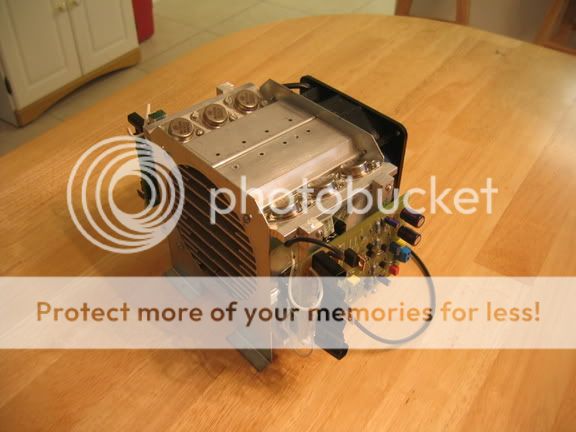
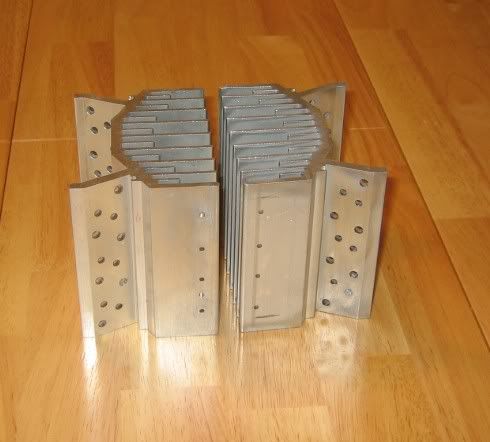
I have a more powerfull fan but it is louder.
I'll try it and see if it makes much difference.
Blessings, Terry
Actually now that I see that lower photo I think you'd find that the sink that Krell used has quite a bit more square inches of radiating surface inside the tunnel. Youf fins are large and then small.... if they were all large fins then you'd be correct and yours would have the same or more square inches of radiating area.
Attachments
- Home
- Amplifiers
- Solid State
- Krell KSA 50 PCB
